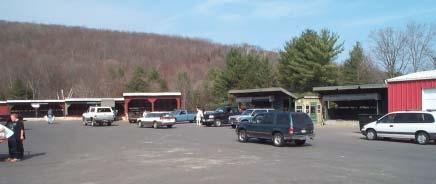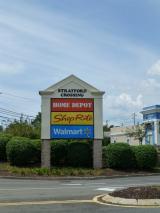Superfund Sites in Reuse in Connecticut
If you are having trouble viewing the map in your browser, click the 'View larger map' link below
Barkhamsted-New Hartford Landfill
 Barkhamsted-New Hartford LandfillThe 98-acre Barkhamsted-New Hartford Landfill Superfund site is located in Barkhamsted, Connecticut. In the 1970s, the unlined landfill accepted municipal and industrial wastes. The site also served as a barrel-crushing and metal reclamation operation. In 1983, a state inspection found leaking drums containing hazardous solvents on site. Site operations contaminated groundwater at the site. EPA placed the site on the Superfund program’s National Priorities List (NPL) in 1989. In the fall of 1999, the landfill owner installed a cap, a runoff and landfill liquid collection and treatment system, and a landfill gas capture system. EPA selected a cleanup plan for groundwater at the site in 2001. It included natural attenuation and long-term monitoring of groundwater, long-term monitoring of surface water and sediment, and restrictions to prevent contact with contaminated groundwater. Today, the site supports an active waste transfer station, recycling area, and maintenance and office buildings.
Barkhamsted-New Hartford LandfillThe 98-acre Barkhamsted-New Hartford Landfill Superfund site is located in Barkhamsted, Connecticut. In the 1970s, the unlined landfill accepted municipal and industrial wastes. The site also served as a barrel-crushing and metal reclamation operation. In 1983, a state inspection found leaking drums containing hazardous solvents on site. Site operations contaminated groundwater at the site. EPA placed the site on the Superfund program’s National Priorities List (NPL) in 1989. In the fall of 1999, the landfill owner installed a cap, a runoff and landfill liquid collection and treatment system, and a landfill gas capture system. EPA selected a cleanup plan for groundwater at the site in 2001. It included natural attenuation and long-term monitoring of groundwater, long-term monitoring of surface water and sediment, and restrictions to prevent contact with contaminated groundwater. Today, the site supports an active waste transfer station, recycling area, and maintenance and office buildings.
For more information:
Cheshire Ground Water Contamination
From 1966 to 1980, two companies manufactured plastic molding at the 15-acre Cheshire Ground Water Contamination Superfund site in Cheshire, Connecticut. Operations contaminated soil and groundwater with chemicals and solvents. In 1990, EPA placed the site on the Superfund program’s National Priorities List (NPL). Cheshire Associates, under state and EPA orders, cleaned up the site by removing some contaminated soil. EPA extended the public water supply to residents with drinking water wells affected by site contamination. Carten Controls, a subsidiary of Fujikin of America, Inc., relocated to the site in 1996. EPA took the site off the NPL in 1997. Carten Controls continues to manufacture parts at the site for the semiconductor industry.
For more information:
Durham Meadows
The Durham Meadows Superfund site is located in Durham, Connecticut. Companies made metal cabinets, boxes and other items on site from 1851 until 1998. Improper storage and disposal practices contaminated site soil and groundwater. In 1982, the Connecticut Department of Energy and Environmental Protection (CT DEEP) found contamination in nearby private drinking water wells. Merriam Manufacturing Company and Durham Manufacturing Company installed filters on affected residential wells. EPA placed the site on the Superfund program’s National Priorities List (NPL) in 1989. Cleanup activities include providing an alternate water supply for affected residents, removing soil, monitoring and containing groundwater contamination, placing restrictions on land and groundwater use, and investigating areas with possible indoor air risks. The Durham Manufacturing Company continues to make metal boxes on site. Cleanup of the Merriam Manufacturing Company area of the site is now complete. The design for the alternative water supply and cleanup of the Durham Manufacturing property are underway. CT DEEP and EPA are working with the responsible parties and local officials to put final land and groundwater use controls in place.
For more information:
Gallup's Quarry
The Gallup’s Quarry Superfund site is a 29-acre abandoned gravel pit in a rural area of Plainfield, Connecticut. Contamination at the site dates back to the 1970s when the site owner accepted chemical wastes without a permit. Disposal activities led to site-wide soil and groundwater contamination. After the Connecticut Department of Environmental Protection removed waste drums and contaminated soil, EPA placed the site on the Superfund program’s National Priorities List (NPL) in 1989. EPA’s cleanup plan includes long-term monitoring and land use restrictions. Soil and groundwater monitoring continue at the site. EPA restricted land use to industrial purposes. Today, the site is home to the Plainfield Renewable Energy biomass facility. The biomass plant became fully operational in January 2014. The 37.5 megawatt biomass power plant uses waste wood to generate enough electricity to power the equivalent of about 40,000 homes in Plainfield. Connecticut Light & Power purchases 80 percent of the generated energy under a 15-year agreement, while the remaining energy contributes to the regional renewable energy certificate market.
For more information:
Linemaster Switch Corporation
The 45-acre Linemaster Switch Corporation Superfund site is located in Woodstock, Connecticut. Electrical and pneumatic foot switches and wiring harness manufacturing occurred on site since 1952. Site operations use chemicals, paint and thinners. Site practices resulted in groundwater, sediment, surface water and soil contamination at the site. In 1990, EPA added the site to the Superfund program’s National Priorities List (NPL). Cleanup activities included installing soil and groundwater treatment systems. Today, the Linemaster Switch Corporation continues to manufacture electrical power switches, air valves, electrical cord sets and metal name plates at the site. The groundwater treatment system remains in operation. The site also includes several residences, a banqueting facility, a restaurant and an inn.
For more information:
Nutmeg Valley Road
Beginning in the 1940s, metalworking and finishing shops operated at the Nutmeg Valley Road Superfund site. The site occupies about 28 acres in Wolcott, Connecticut. Two machine shops, with a known history of dumping chemicals on the ground, became the focus of attention when EPA identified contamination in private drinking water wells near the site. In 1989, EPA placed the site on the Superfund program’s National Priorities List (NPL). In 1992, an emergency cleanup action addressed surface soil contamination and removed a potential source of groundwater contamination. After the cleanup action, groundwater studies found naturally decreasing contaminant levels and no evidence of a widespread contaminated groundwater plume. These findings, along with a state law and a local ordinance prohibiting groundwater use at the site, allowed EPA to determine that no further action was needed at the site. EPA took the site off the NPL in 2005. EPA issued a site reuse profile providing information on the site’s reuse status. Industrial and commercial use with some residential use along Wolcott Road continues at the site. In an effort to revitalize the area, the Town of Wolcott made infrastructure improvements to area roads and offered visual enhancement incentives. Local officials point to site improvements and the site’s removal from the NPL as factors that led to the construction of a $2 million state-of-the-art greenhouse next to the site. The Town of Wolcott expects these factors to improve consumer confidence and encourage additional commercial and industrial development of the site.
For more information:
Old Southington Landfill
The Old Southington Landfill Superfund site occupies 11 acres in Southington, Connecticut. From the 1920s, the site operated as a municipal landfill. In 1967, the Town of Southington closed the landfill. Closure activities included compacting loose waste, covering the landfill with clean material and reseeding the area with grasses. Between 1973 and 1980, parties subdivided and sold the landfill property for residential and commercial development. Construction of several residential and commercial structures took place at the site and in surrounding areas. In 1979, groundwater sampling at a public water supply well near the site found contamination in groundwater. The Town of Southington closed the well. Further investigations found groundwater, soil and surface water contamination at the site. EPA placed the site on the Superfund program’s National Priorities List (NPL) in 1984. Cleanup activities included relocation of on-site structures, installation of a landfill cap, disposal of semi-solid waste materials into a lined cell beneath the cap, construction of a soil gas collection system, and long-term monitoring. Cleanup activities also include environmental land use restrictions on properties that have potential future risk from contaminated vapors that could move from groundwater through building slabs. The U.S. Fish and Wildlife Service will use funds from the potentially responsible parties to restore ecological habitat, including waterways and natural resources affected by the site. Trail maintenance work along the Quinnipiac River will also take place to allow for recreational use.
For more information:
Raymark Industries, Inc.
The Raymark Industries, Inc. Superfund site includes over 500 acres near the Housatonic River in Stratford, Connecticut. From 1919 until 1989, Raymark Industries, Inc. made brakes, clutch parts, and other friction components used primarily in the automotive industry on a 34-acre area. Disposal of manufacturing wastes, containing components now considered hazardous, took place on site, on nearby residential, commercial and municipal properties, and in the wetlands next to the Housatonic River. Contaminated groundwater from beneath the former facility impacted a residential area due to contaminated groundwater vapors in buildings. Between 2003 and 2004, EPA installed over 100 sub-slab ventilation systems in homes. EPA placed the site on the Superfund program’s National Priorities List (NPL) in 1995. Cleanup activities included removing contaminated soil and waste, capping, installing vapor extraction systems and restricting site access. People near the site do not currently use groundwater for drinking purposes. EPA considered reuse during cleanup when constructing the cap over the entire 34-acre area. The cap allowed for redevelopment of the property while ensuring the remedy remained protective. EPA awarded the site a Superfund Redevelopment pilot grant in 2001. The Stratford Crossing Shopping Center, completed in 2002, currently occupies the site. The shopping center provides a mixed green and commercial space. The community enjoys access to several businesses including Home Depot, ShopRite Supermarket, Walmart and Webster Bank.
For more information:
- Reuse and the Benefit to Community: Raymark Industries, Inc. Superfund Site (PDF)(9 pp, 1.3 MB)
- Superfund Site Profile Page
Scovill Industrial Landfill
For more information:
Solvents Recovery Service of New England
The Solvents Recovery Service of New England Superfund site is located in Southington, Connecticut. The site includes a 4-acre former operations area and a 42-acre groundwater contamination plume. A hazardous waste treatment and storage facility began operating at the site in 1955. During operations, spills occurred and operators stored process wastes in unlined lagoons. Site practices resulted in soil and groundwater contamination. In 1979, two public water supply wells downgradient of the site were found to be contaminated, and were closed. EPA placed the site on the Superfund program’s National Priorities List (NPL) in 1983. In 1991, all activities at the site ended in preparation for facility closure under the Resource Conservation and Recovery Act (RCRA). EPA conducted short-term cleanup activities to remove 19 drums of contaminated materials. Cleanup activities also include treating groundwater, consolidating and capping contaminated soil, monitoring, and restricting groundwater and land use. Cleanup is ongoing. The U.S. Fish and Wildlife Service will use funds from potentially responsible parties to restore ecological habitat including waterways and natural resources affected by the site. Trail maintenance work along the Quinnipiac River, as well as the construction of a new section of the nearly 80-mile long Farmington Canal Heritage Trail, which runs across the site, will allow for recreational use.
For more information:

